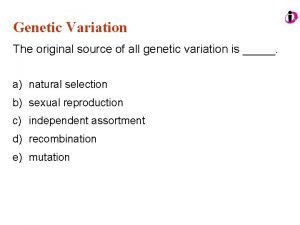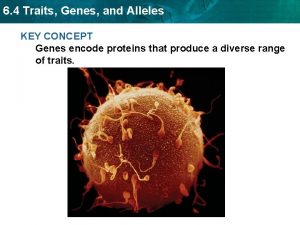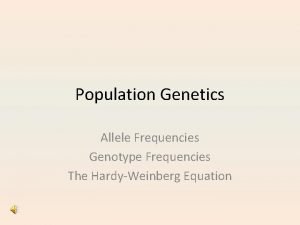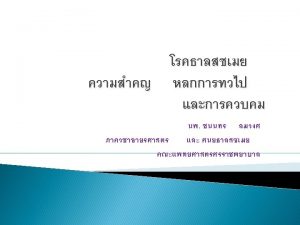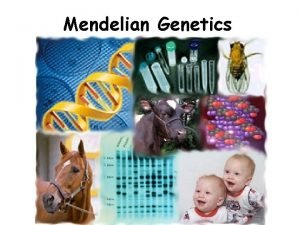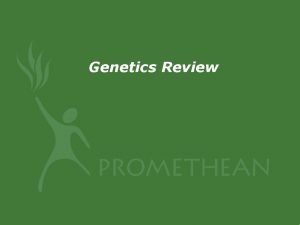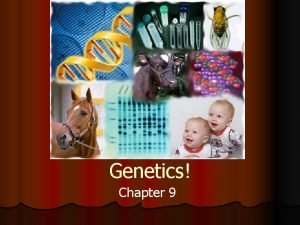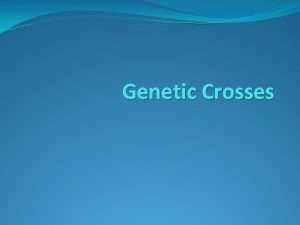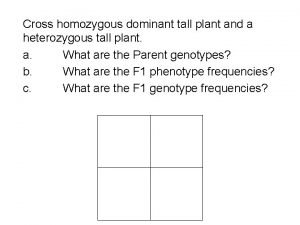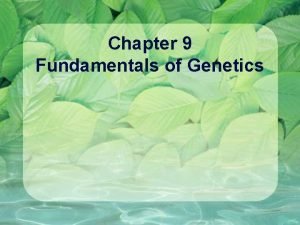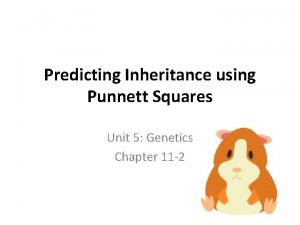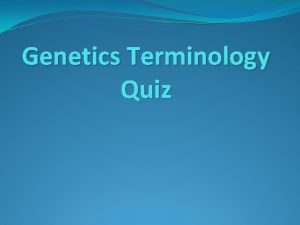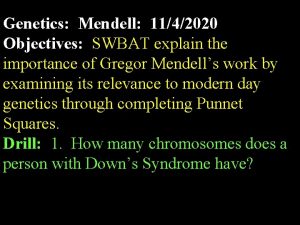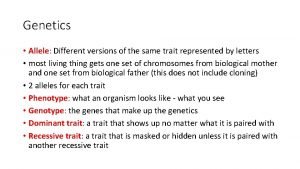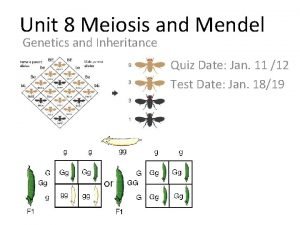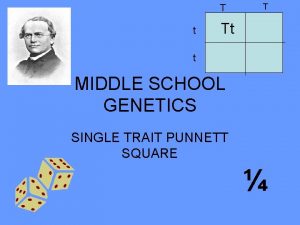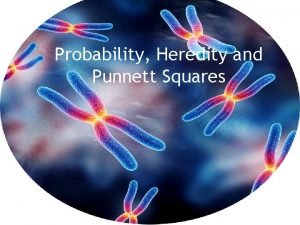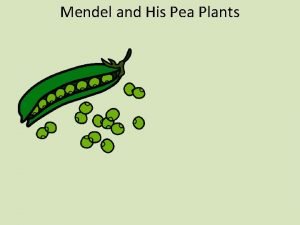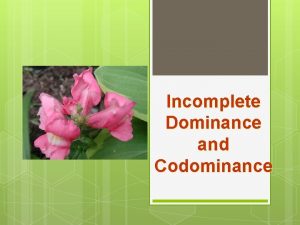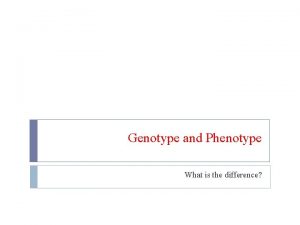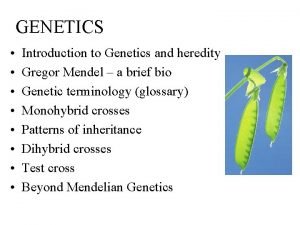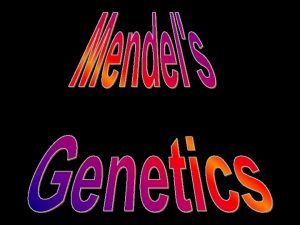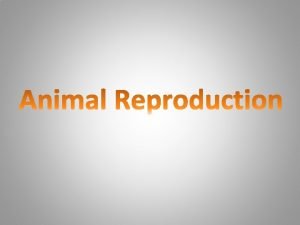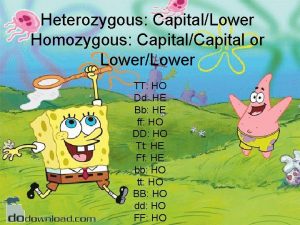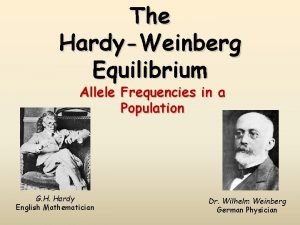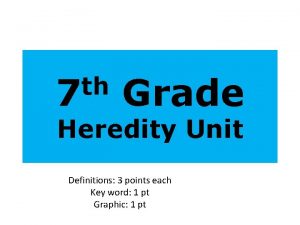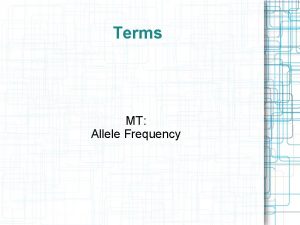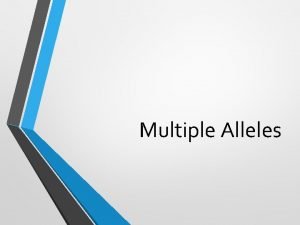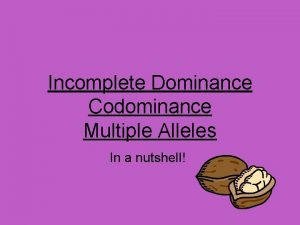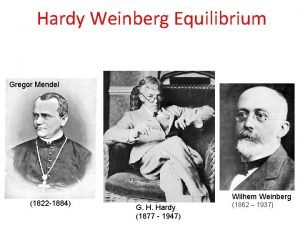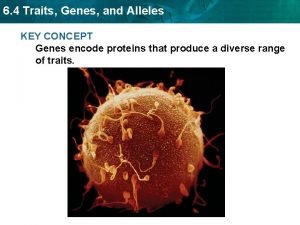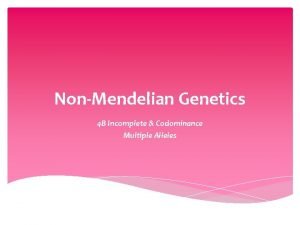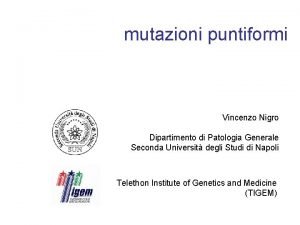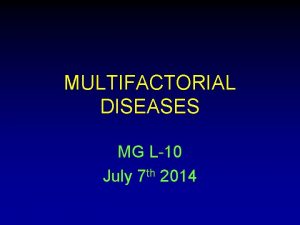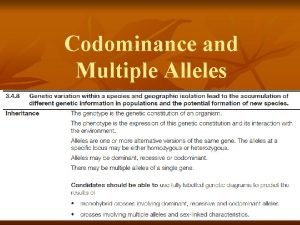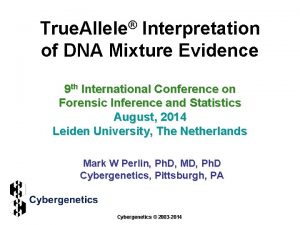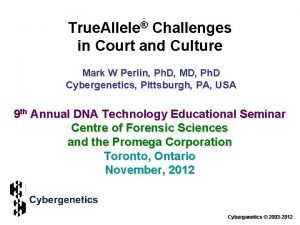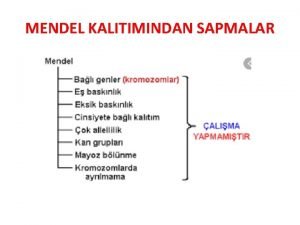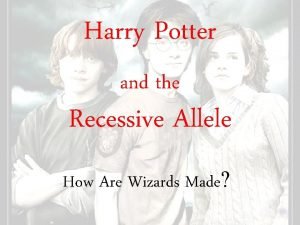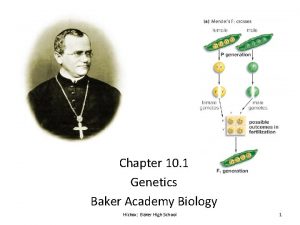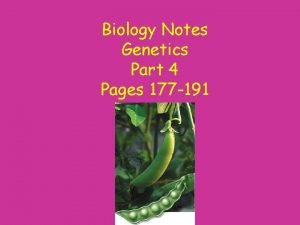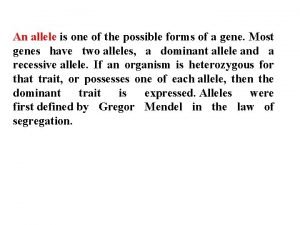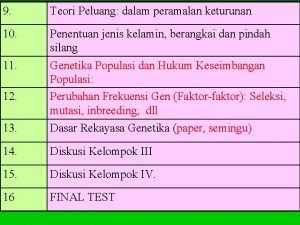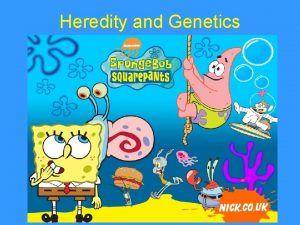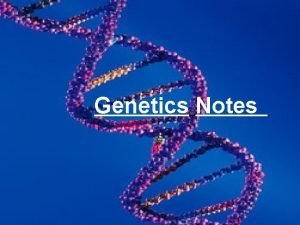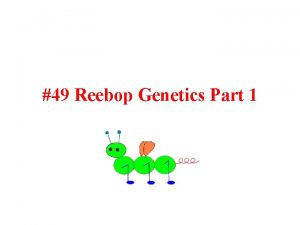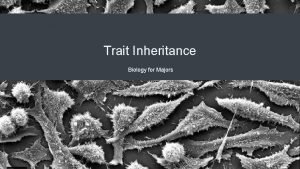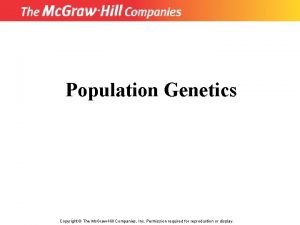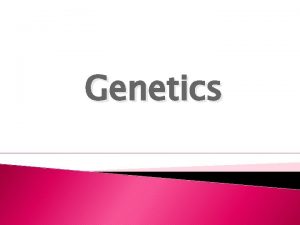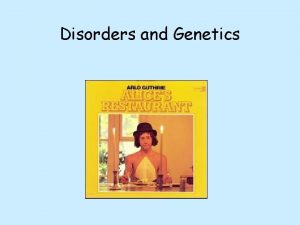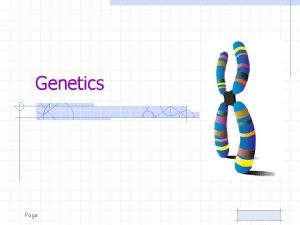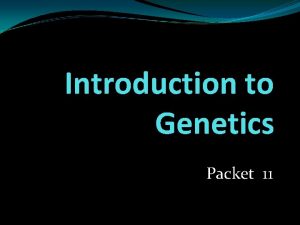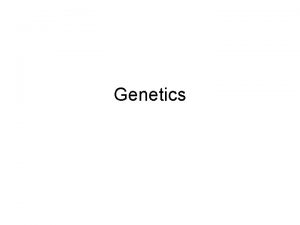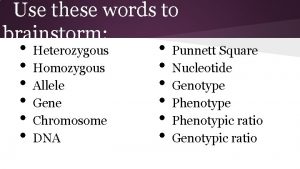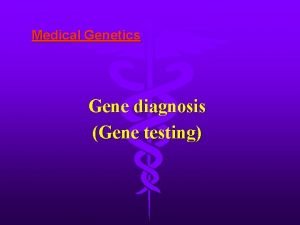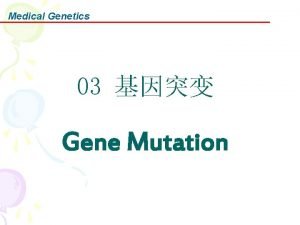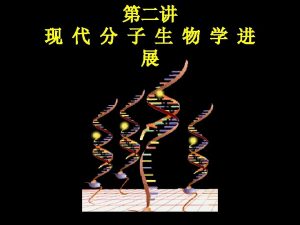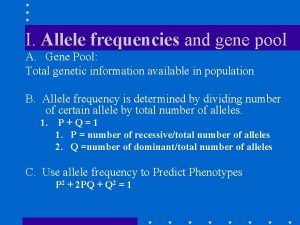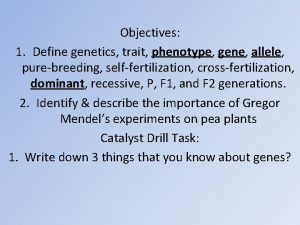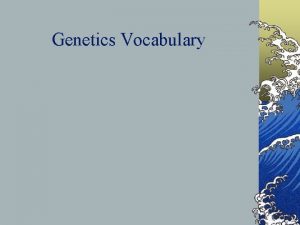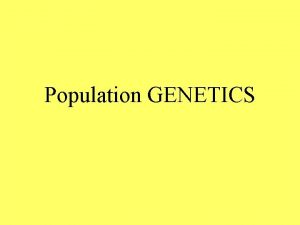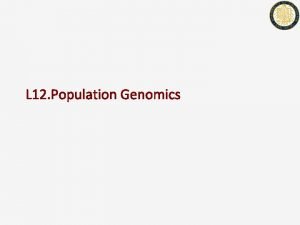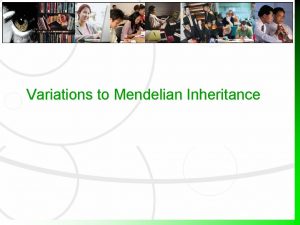Packet 7 Genetics Word GENE ALLELE HOMOZYGOUS or




























































- Slides: 60

Packet 7 Genetics

Word GENE ALLELE HOMOZYGOUS or Purebred Vocabulary Definition Picture/Example A segment of DNA that codes for a protein Alternate forms of a gene A or a (1 letter) Two alleles are the same. AA or aa

Word Vocabulary Definition HETEROZYGOUS Two alleles are different. Or Hybrid DOMINANT RECESSIVE Picture/Example Aa Trait that is automatically seen even when paired with a recessive allele. AA or Aa (dimples) Trait that is only seen when two recessive alleles are present. aa (no dimples)

Word GENOTYPE PHENOTYPE PUNNETT SQUARE Vocabulary Definition Picture/Example Genetic make-up of an individual. AA, Aa or aa Physical characteristic. How you see the trait. A box that is used to predict the probability of offspring when crossing two parents. Dimples or no dimples

Gregor Mendel • • • Gregor Mendel __________(1822 -1884) today he is considered to be the father of modern genetics. Genetics is the branch of biology that studies ________ heredity or the passing of traits from parent to offspring. pea plants. He determined 3 things Mendel worked with _______ from his studies: TWO copies of a gene (one from – For each trait an individual has ____ each parent) – There alternate forms of genes called alleles __________. – There are dominant and recessive _______ alleles.

• Mendel’s findings led to two laws of heredity: Law of Segregation - 2 alleles for a trait – ______________ separate during meiosis when gametes are formed b/c homologous chromosomes and sister chromatids separate. – Law of Independent Assortment ______________________- alleles for different traits separate independently from one another during meiosis. In other words inheritance of one trait does not influence inheritance of another. For example if you have blond hair you will not necessarily get blue eyes. These traits are inherited separately.


Nature vs. Nurture • Genes determine the physical trait, but environment can also play a role in how the trait is expressed. – Example 1: Height and weight. Genes determine this trait, but environment can play a big role. If a person has genes for being very tall, but does not have the proper nutrition while growing up, then they may not be as tall as their genes would allow. – Example 2: Fur color in some animals. Genes determine fur color, but some animals have fur that changes depending on the season. The arctic fox for instance has a white coat in the winter but a brown coat in the summer.

Now you practice identifying the genotypes and phenotypes using the following traits and symbols. TRAIT DOMINANT ALLELE RECESSIVE ALLELE Seed shape R = round r = wrinkled Seed color Y = yellow y = green Seed coat color G = gray g = white Flower position A = axial a = terminal Plant height T = tall t = short

Complete the following table using the symbols and traits found above: Trait Genotype (symbol) Phenotype seed shape RR Round seed shape Rr Round seed shape rr Wrinkled plant height TT or Tt tall plant height tt short flower position aa terminal flower position AA or Aa axial seed coat color Gray Gg

Write the correct symbols for the following genotypes. Circle those that are not possible. pure tall stems TT homozygous yellow seeds YY pure short stems tt pure green seeds yy homozygous terminal flowers aa hybrid round seeds Rr pure round seeds hybrid tall stems RR homozygous axial flowers AA homozygous wrinkled seeds rr Tt Heterozygous wrinkled seeds ___ hybrid axial flowers Aa heterozygous short stems__ heterozygous yellow seeds Yy heterozygous seed coat color. Gg • Why are some of these not possible? You cannot have a heterozygous recessive organism. The only way to show a recessive trait is to have two small letters (yy). • Can I always identify the genotype if I know the phenotype? Explain your answer. No, If you know a plant is tall you don’t know if the genotype is TT or Tt.

HOW TO DETERMINE IF A TRAIT CAN BE PASSED ON TO THE OFFSPRING • • • Probability ________ is the likelihood that an event will occur. – So if we know the genetic makeup of the mom and dad, we should be able to figure out if it is probable and/or possible for them to pass down certain traits. Punnett square We will use a box called a ____________ to determine the probability that specific traits will be passed down from parent to offspring. Monohybrid __________ cross- a cross that involves one pair of contrasting traits. E (_____ Female genotype) Ee E e e EE Ee Ee ee (_____ - Male genotype) Ee

PRACTICE PROBLEM: In pea plants, tall is dominant over short. (T = tall, t = short) • What letters will represent a heterozygous tall plant? Tt • What letters will represent a homozygous short plant? tt

• What type of offspring would result if we crossed a heterozygous tall plant with a short plant? Complete the Punnett square below to find out. – Parents (P) = Tt X tt T t t Tt tt ◦ What are the possible genotypes of the offspring (include fractions)? 0/4 TT 2/4 Tt 2/4 tt ◦ What is the genotypic ratio? 0 TT : 2 Tt : 2 tt ◦ What are the possible phenotypes of the offspring (include fractions)? 2/4 Tall 2/4 Short ◦ What is the phenotypic ratio? 2 tall : 2 short Dominant : Recessive

Punnett Square Practice Complete the punnett squares and questions for each of the following genetic crosses. YOU MUST SHOW ALL WORK TO GET CREDIT!!! 1. Red flowers are dominant to white flowers. (R = red, r = white) a) What letters will represent a homozygous red flowered plant? ______ b) What letters will represent a homozygous white flowered plant? _____ c) Cross a homozygous red plant with a white plant: RR x rr R R r Rr Rr d) 1. 2. 3. 0 0 4 4 0 4 0 0 List the possible genotypes? _____/4 RR, _____/4 Rr, _____/4 rr What is the genotypic ratio? ____ : ____ What are the resulting phenotypes? ___/4 red, ___/4 white What is the phenotypic ratio? ____: ____ RR rr

2. a) b) c) In pea plants, round seeds are dominant to wrinkled seeds. (R=round, r=wrinkled) Tell the genotype of a pea plant that is heterozygous for round Rr seeds? _______ Cross a heterozygous plant with another heterozygous plant. What are the genotypes of both parents? Parent (P): ______ X ______ Rr Rr R r d) e) f) g) R RR Rr rr 1 List the possible genotypes? ___/4 RR, ___/4 Rr, ___/4 rr 2 1 What is the genotypic ratio? ____ 1 : ____: 2 ____ 1 What are the resulting phenotypes? ___/4 wrinkled 3 round, ___/4 1 3 1 What is the phenotypic ratio? ____: ____

3. In pea plants, green pea pods are dominant to yellow pea pods. (G=green, g=yellow) G g g Gg gg g A. B. C. D. Cross a heterozygous plant with a yellow plant. What are the genotypes of both parents? Parent Gg gg (P): ______ X ______ 0: 2: 2 What is the genotypic ratio _________ What is the phenotypic ratio? ________ 2: 2

Using Punnett Squares to Predict the Outcomes of Crosses TRAIT DOMINANT ALLELE RECESSIVE ALLELE Pod shape N = smooth n = wrinkled Pod color G = green g = yellow Flower position A = axial a = terminal Plant height T = tall t = short

4. Cross a plant that is heterozygous for axial flowers with a plant that has terminal flowers. Aa x aa A a a Aa aa 0: 2: 2 Genotypic Ratio: _______ 2: 2 Phenotypic Ratio: _______

5. Cross two plants that are both heterozygous for green pods. Gg x Gg G GG Gg gg 1: 2: 1 Genotypic Ratio: _______ 3: 1 Phenotypic Ratio: ______

6. When a tall plant is crossed with a short plant, some of the offspring are short. What are the genotypes of the parents and the offspring? What would be the expected phenotypic ratio of the offspring? (Hint #1: You may need to work backwards with this problem. #2: You should have two punnett squares drawn to prove your point). Let’s try this … How about this … Tt x tt TT x tt T T T t t Tt Tt tt must be Tt x tt since get some tall and Genotypes of Parents: some short plants _______ 0: 2: 2 Possible genotypes of offspring: ______ Phenotypic Ratio: 2: 2

7. Three-fourths (3/4) of the plants produced by a cross between two unknown pea plants have axial flowers and ¼ have terminal flowers. What are the genotypes of the parent plants? SHOW YOUR WORK A a A AA a Aa Aa aa Parental Genotype: Aa x Aa

NOTES: TEST CROSSES • TEST CROSS is used to determine the A _________ unknown genotype of a specific organism. – In most cases, if you have an organism that is showing dominant the _________ trait, you can not tell if they are homozygous or heterozygous by looking at them. – It is possible to determine their genotype by crossing (breeding) the unknown with an individual that is recessive homozygous _________. By looking at their offspring you can usually determine the genotype of the unknown parent.

• Example: In tulips, red is dominant over white. When you see a red flower you can’t be sure if the flower is homozygous red (RR) or heterozygous red (Rr). To determine this you can cross it with a plant that produces white (rr) flowers (homozygous recessive) & observe the color of the offspring. Possibility #1: Red (R? ) x white (rr) R r r Rr rr If some are white and some red then the genotype must be Rr Possibility #2: Red (R? ) x white (rr) R R r Rr Rr If all of the tulips are red then the parent must be RR.

Sample test cross: In dogs, there is a hereditary deafness caused by a recessive gene, “d. ” A kennel owner has a male dog that she wants to use for breeding purposes if possible. • The dog can hear, so the owner knows his genotype is either DD or Dd. • If the dog’s genotype is Dd, the owner does not wish to spend the money to use him for breeding. • The only way to be certain is to breed the dog with a deaf female (dd) and observe the offspring that they produce. 1. If the male dog is DD what is the probability that he would 0% pass on the allele for deafness? ____ 2. If the male dog is Dd what is the probability that he would pass on the allele for deafness? _____ 50% 3. Since the female is dd what is the probability that she would pass on the allele for deafness? ____ 100%

Since we do not know what the genotype of the male is, we will complete both punnett squares below to show the possible outcome of the test cross: Assume the male is DD Assume the male is Dd D D D d Dd dd d Dd Dd dd d Dd 4. 5. If he is DD, what percentage of the puppies would be expected to have normal hearing? _____ 0% 100% deaf? ______ If he is Dd, what percentage of the puppies would be expected to have 50% deaf? ______ 50% normal hearing? _____ Dd but If any of the puppies are deaf, the male’s genotype MUST BE _______; assuming a litter of at least about 4 to 5 puppies or more, if they can all DD hear, his genotype is MOST LIKELY _____.

Dihybrid Crosses Sometimes instead of just comparing a single trait (like we have been with the four box punnett square) – we will compare two different traits at the same time. This is called a ________ cross. DIHYBRID B = Black Nose b = pink Nose L = Long ears l = short ears Use the Punnett square seen below to answer questions.

Dihybrid Crosses bb. RR What letters would go in Box X? _________ bbrr What letters would go in Box Z? _________ What are the genotypes of the parent’s of this cross? Bb. Rr Bb. Rr _____________ What percent of offspring are expected to have a white coat of fur? 4/16 = 25%

Complex Genetics Term Definition Complete Dominance One allele is dominant over the other. Incomplete Dominance The dominant allele will not fully cover up a recessive allele and the trait will be a result of the two blending or mixing together. Codominance Two different alleles are expressed at the SAME time. RR Rr rr

In carnations, incomplete dominance can be seen in flower color: ◦ red (RR) pink (Rr) Cross two pink carnations. Write the genotypes of the parents white (rr) Rr x Rr R RR r Rr ◦ ◦ ◦ Rr rr Genotypic ratio: 1 RR : 2 Rr : 1 rr Phenotypic ratio: 1 red : 2 pink : 1 white What percent of the offspring are pink? 50% _______

In humans, hair texture is due to an incompletely dominant trait. Straight hair (H) is incompletely dominant to curly hair (h). When crossed, they produce a heterozygous individual with wavy hair (Hh). Using a Punnett square, cross a curly-haired person with a wavyhaired person. Write the genotypes of the parents h h H Hh Hh h hh hh 0 HH : 2 Hh : 2 hh Phenotypic ratio: 0 straight: 2 wavy: 2 curly 0% What percent of the offspring will have straight hair? _______ ◦ Genotypic ratio: ◦ ◦ hh x Hh

An example in humans of incomplete dominance: In humans, red blood cells contain a protein called hemoglobin. It is the hemoglobin that gives the red blood cell its color and ability to pick up oxygen and carry to other cells. Normal hemoglobin (no sickle cell anemia) are homozygous (HAHA) ◦ Their red blood cells are disk shaped, soft/flexible and live for about 120 days. Individuals that carry the sickle cell allele are heterozygous (HAHS) ◦ People with this genotype have a milder form of the disease. Individuals with sickle cell disease are homozygous (HSHS) ◦ Red blood cells can becomes sickle shaped, rigid and live about 20 days. They also tend to get stuck in narrow blood vessels, which may cause complications.

Cross between 2 sickle cell carriers Complete a punnett square to determine the chances of two sickle cell carriers having a homozygous normal child? AH S Genotype of parents: H____ x H______ HA HS HA H AH S HS HS 25% chance of a homozygous normal child

Codominant alleles are written as capital letters with superscripts(HR). Since these traits are inherited from both parents, it is important to still use two ‘sets of letters’ as seen below. The allele for red hair (HR) is codominant with the allele for white hair (HW) in cattle. Cattle that have the genotypes HRHW are called roan because their hair is a mixture of red & white hairs.

Codominance Practice Problems HRHR = Red HRHW = roan Cross a red cow and a white bull: HR HR HW HRHW HWHW = White RH R W HW H H ________ X _________ RHR : 4 HRHW : 0 HWHW 0 H What is the genotypic ratio of the offspring? ______ 0 red: 4 roan : 0 white What is the phenotypic ratio of the offspring? ______ What percent of the offspring are roan? 100%

Codominance Practice Problems In chickens, black feather color (FB) is codominant to white feather color (FW). The heterozygous individual is a combination of black and white feathers that results in a checkered pattern (FBFW). Cross a checkered chicken and a black chicken. ____ X _____ FBFW FB F BF W FB F BF W FBFB 2 F F : 2 F What is the genotypic ratio of the offspring? ______ 2 black : 2 checkered : 0 white What is the phenotypic ratio of the offspring? ______ What percent of the offspring are black? B B 50% BFW : 0 FWFW

Blood Types TWO alleles (or forms Multiple Alleles - A gene that has more than ____ of a gene). In other words, not just one dominant and one recessive allele (i. e. R and r). O A B AB No antigens A antigen Both A & B antigens

Blood Typing Practice Problem #1 1. A man with type O blood marries a woman with type AB blood, what are the possible blood types of their children? i i IA IA i IAi IB 50% 0%

Blood Typing Practice Problem #2 2. Is it possible for a man with type A blood and a woman with type B blood to have one child with type O blood another child with type AB Blood? Why or why not? Show your work!!! I A i I B IA IB IBi i IA i ii Yes, if both parents are heterozygous.

Do you know your blood type? Are you positive? Red blood cells may also have a second antigen called __________. This trait complete dominance. Phenotype Rh Positive Rh Negative Genotypes: (Rh+ Rh+) or (Rh+ Rh-) (Rh- Rh-) Appearance of Red Blood Cells (dominant) (Recessive)

What type of blood can you get? Blood cells have different proteins on their surface and this determines the blood type. These proteins are called ________. If you have A blood you produce the A antigen, people with O blood produce NO antigen. The body’s immune system produces __________ (another type of protein) that recognize antigens on foreign cells and attacks them. Antibodies and antigens match up like a lock and key. Your body produces antibodies against antigens that YOU DO NOT HAVE. If your body produced antibodies for antigens you have then your body would attack itself.

A anti-B B or AB A or O B anti-A A or AB B or O A & B none None A, B, AB or O none Both anti-A & B A, B, AB O + none None + or - none anti-Rh + -

Universal Donor vs. Universal Recipient Type O- is known as the UNIVERSAL DONOR _______. Since there are no antigens on the blood cells it can be given to any of the blood types. Even though other blood types make antibodies, the antibodies have nothing to attach to on the O blood cells. O- can only get from O- since they make antibodies to all other blood types. UNIVERSAL RECIPIENT Type AB+ is called the ________________. A person with type AB blood could receive a transfusion from any blood type since they don’t make antibodies to any of them. Rh Factor and pregnancy – If a mom is Rh- then she makes antibodies that attack blood cells with the Rh+ antigen. If her baby is Rh+, then the baby may be harmed. Luckily there is an injection the mom can get to prevent her body from harming the baby.

Notes: Polygenic Traits are controlled by the interaction of more than one gene. These traits tend to show great degrees of variation.

If two parents have a medium skin tone (Aa. Bb. Cc), their children could have: ______________________ By looking at the graph, we can see that it is most likely that their kids will have ______ skin tone.

In humans, other examples of polygenic traits:

Sex-Linked Traits 1. Genes which are located on the sex chromosomes are said to be sex-_______. ◦ Not all genes on the sex chromosomes control gender (i. e. color-blindness & hemophilia) 2. Most sex-linked traits occur more frequently in ____ because they have only ___ X chromosome (males cannot be carriers for sexlinked traits, if they inherit the gene for a sexlinked disorder they will show it).

COLOR BLINDNESS _________ (Xn) is a very common sex-linked trait and is recessive to normal vision (XN). More males have this disorder than females. X NY XN XN XNXN Xn Y XNY Xn. Y XNXn ¼ = 25% ½ = 50%

Color-blindness practice problem # 2 Xn XN XNXn XN XN Xn Y XNY 2/2 or 100% chance of having a daughter who is a carrier

Hemophilia practice problem # 1 In humans, hemophilia is a sex-linked trait located on the X chromosome. Normal blood is dominant (XH) to hemophilia (Xh). A heterozygous female is referred to as a carrier. Using a Punnett square, cross a female with hemophilia with a normal male. XHY Xh. Xh __________ X _________ H X Y HXh Xh. Y h X X Xh XHXh Xh. Y What percentage of this couple’s daughters will have hemophilia? __ 0% 100% What percentage of this couple’s sons will have hemophilia? ______

Hemophilia practice problem # 2 In humans, hemophilia is a sex-linked trait located on the X chromosome. Normal blood is dominant (XH) to hemophilia (Xh). A heterozygous female is referred to as a carrier. Cross a carrier female with a male with hemophilia. Xh. Y XHXh __________ X _________ h X Y HXh XHY H X X Xh Xh. Xh Xh. Y What percentage of this couple’s sons will have hemophilia? __ 50% What percentage of this couple’s daughters will have hemophilia? ______

Notes: Pedigrees & Genetic Disorders Biologists use charts called PEDIGREES _________ to study the pattern of phenotypic inheritance in individuals and their family. Some of the most common symbols used:

Reading Pedigrees SQUARE CIRCLE SHADED HALF-SHADED

Determining Inheritance Patterns Using Pedigrees GENETIC DISORDERS are diseases or debilitating conditions that have a genetic basis. When looking at pedigrees you will need to determine if the disorder is: Autosomal or sex-linked Dominant or recessive

Determining Inheritance Patterns Using Pedigrees Tips to determining this: If a disease is autosomal it will appear about EQUALLY in males and females. _______ If a disease is sex-linked it will appear in more MALES ______ than females. If a disease is recessive than it is possible for BOTH _______ parents to be normal but have a child that has the disease. If a disease is dominant than at least ONE __________ of the parents will have the disease.

Pedigree 1 Circle one in each pair: Autosomal or Sex-linked Dominant or Recessive B/c same # of males and females have it. B/c there are unaffected parents but a child with the disease

Pedigree 2 Circle one in each pair: Autosomal or Sex-linked B/c in more females. Dominant or Recessive B/c for every child with the disease at least one parent has the disease.

Pedigree 3 Circle one in each pair: Autosomal or Sex-linked Dominant or Recessive B/c in more males. B/c there are unaffected parents but a child with the disease

Well-known Autosomal Genetic Disorders: Disorder Symptoms Pattern of Inheritance Frequency among human births Huntington’s Disease Gradual deterioration of brain tissue in middle age; shortened life expectancy Autosomal Dominant 1/10, 000 Cystic Fibrosis Mucus clogs lungs, liver and pancreas; victims don’t survive to adulthood Autosomal Recessive 1/2, 080 (whites) Sickle Cell Anemia Impaired blood circulation; Organ damage Autosomal Recessive 1/500 (African American) Tay-Sachs Disease at birth, but deterioration of central nervous system begins in infancy; death occurs in early childhood Autosomal Recessive Phenylketonuria (PKU) Inability of the body to break down the amino acid phenylalanine. Failure to limit the amino acid in the diet causes it to accumulate, which leads to problems w/brain development, seizures and possibly mental retardation. Autosomal Recessive 1/1, 600 (Jews-European Descent) 1/15, 000 Caucasians and Asians (less in African Americans)

Well-known Sex-Linked Genetic Disorders: Disorder Symptoms Pattern of Inheritance Frequency among Human births Hemophilia Failure of blood to clot X-linked Recessive 1/7, 000 Muscular Dystrophy Wasting away of muscles X-linked Recessive 1/3500 males Colorblindness Individuals cannot distinguish between certain colors (most common can’t distinguish red from green) X-linked Recessive 1/12 males 1/200 females
 Components of genetic variation
Components of genetic variation Xhams
Xhams Allele vs gene
Allele vs gene Allelic frequencies
Allelic frequencies Gene by gene test results
Gene by gene test results Chapter 17 gene expression from gene to protein
Chapter 17 gene expression from gene to protein Packet 22 inequality word problems
Packet 22 inequality word problems Thalassemia
Thalassemia Rr x rr
Rr x rr Colorblind punnett square
Colorblind punnett square Heterozygous and homozygous
Heterozygous and homozygous Define homozygous
Define homozygous Homozygous and hetrozygous
Homozygous and hetrozygous Homozygous dominant crossed with heterozygous
Homozygous dominant crossed with heterozygous What is phenotype
What is phenotype Punnett square percentages
Punnett square percentages Gene terminology
Gene terminology Heterozygous recessive
Heterozygous recessive Homozygous letters
Homozygous letters Rr x rr genotype ratio
Rr x rr genotype ratio Punnett square
Punnett square Tgenetics
Tgenetics Tt x tt
Tt x tt Dominant phenotype
Dominant phenotype Phenotype of pea plants
Phenotype of pea plants Homozygous example
Homozygous example Whats the difference between genotype and phenotype
Whats the difference between genotype and phenotype Mendelian principles
Mendelian principles Punnett square example problems
Punnett square example problems Female vocabulary
Female vocabulary Sponge susie roundpants
Sponge susie roundpants Hardy weinberg equilibrium
Hardy weinberg equilibrium Th
Th Allele frequency def
Allele frequency def Ao+ blood type
Ao+ blood type How to calculate allele frequency
How to calculate allele frequency Sickle cell disease incomplete dominance
Sickle cell disease incomplete dominance Codominant allele
Codominant allele Hardy weinberg equilibrium conditions
Hardy weinberg equilibrium conditions Allele definition
Allele definition Allele vs trait
Allele vs trait Codominant allele
Codominant allele Allele antimorfo
Allele antimorfo How to calculate allele frequency from genotype
How to calculate allele frequency from genotype Allèle
Allèle Definition of ph
Definition of ph Codominant allele
Codominant allele True allele
True allele Cybgen
Cybgen Kodominantlık
Kodominantlık Lily evans potter
Lily evans potter Dominant allele definition
Dominant allele definition Dominant allele definition
Dominant allele definition Test cross definition
Test cross definition Dna komplemen
Dna komplemen Heredity examples
Heredity examples Allele
Allele Allele neomorfo
Allele neomorfo Allele
Allele Incomplete penetrance
Incomplete penetrance Gene frequency
Gene frequency
